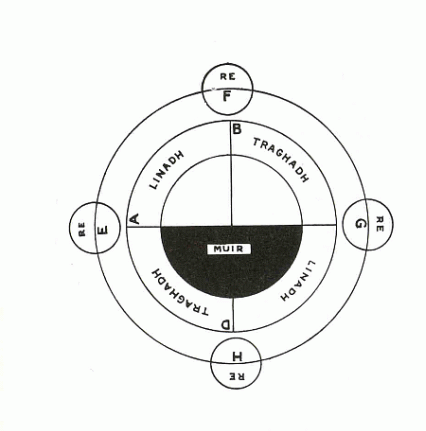
The moon acts visibly on the sea and on the other moist things, for the philosophers say that the sea never ceases flowing from the time the moon is in the east of its circuit, until the time it is at the topmost part of the circuit, and that it does not cease then constantly ebbing until it is setting in the westerly point of its circuit, and that it does not cease then constantly flowing until the moon is in the middle point of its circuit beneath the earth; and from
Thus, according to the rising and setting of the moon, the sea never ceases flowing and ebbing, and when the moon is in the same degree as the sun, then its light is greatest and strongest, i.e., at the beginning of each month, and it is then the ebb and flow of the tide are greatest. In the second course of the moon the ebb and flow of the tide are greatest in the middle of every month, when the moon has its full light, facing us, for it is then the light of the sun is reflected down from the moon towards the sea and brings about the ebb and flow of the tide.
Thus, too, the moon reveals the same acts in the marrow, brain, and blood of men, because those three things are increased and decreased in the beginning and middle of every month according to the course of the moon. And, accordingly, diseases caused by bad blood, such as boils and many other things, do not occur except at the beginning and middle of every month.
The actions of the moon are evident again in accordance with increase and decrease, in the cucumbers and gourds and in every thing in which moisture preponderates, according to the course of the moon. The natural cause of that is that the moon controls moist things and particularly the water of the sea, as lodestone does iron, for as lodestone attracts the iron to itself, in the same way the moon attracts the water of the sea, and that is termed the flow of the tide. When that attraction ceases, the tide turns back to its own position, and that is termed ebb.
This ebb and flow are more visible in the east and west of the world than in the Red Sea or in the African
To explain those operations of the moon as regards the ebb and flow of the tide, I will make a geometrical figure here below, and first I will make the round figure of the earth and divide it into four equal parts, and write these four letters in their respective places around these four divisions, i.e., A, B, C, D, and around the earth I will describe the figure of the sphere of the moon, and place E in the east of it and F in the centre of the top and G in the west and H in the centre of the lower part, and I will darken half of the globe to represent the sea and leave the other half dry and white. Thus when the moon is in the east of its own circle at a point E exactly opposite A the tide then begins to fill and does not cease constantly filling until the moon reaches point F that is opposite D, and then the tide begins to ebb and does not cease constantly ebbing until the moon reaches point G which is opposite C. It is ever filling until the moon reaches point H opposite D, and it is ever again ebbing until the moon arrives opposite A.
